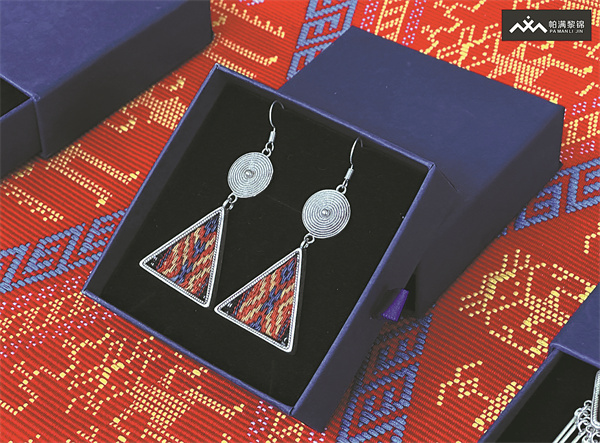
Wang's brocade products include earrings and round fans, as well as traditional cloth for dressmaking.
For over 3,000 years, the intricate art of Li brocade — spinning, dyeing, weaving and embroidering — has been a hallmark of family tradition in Hainan province, passed down primarily from mothers to daughters.
This unique craft has served as a living testament to the deep familial bonds that have kept it alive through the generations.
Yet, the legacy of Li brocade is now being upheld by an increasing number of young practitioners, including male descendants of renowned artisan families.
They have breathed new vitality into the art that used to be dominated by women and are playing an active role in preserving and advancing the craft through establishing their own businesses and engaging in cultural exchanges.
Each time Wang Zhongwen settles before a waist-strapped loom and buries his head in the Li brocade weaving, he sets himself apart from the female practitioners.
The man in his 20s recently returned home to central Hainan's Qiongzhong Li and Miao autonomous county from a brocade exhibition in Beijing in mid-February.
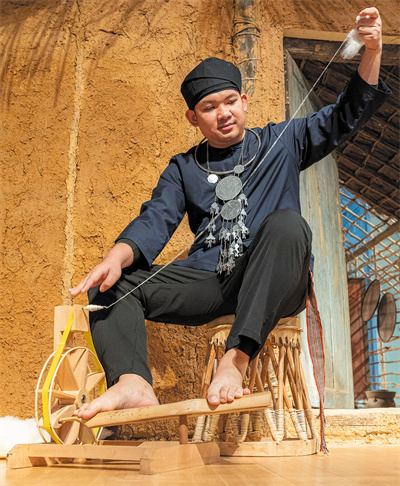
Wang Zhongwen, in his 20s, engages in the spinning, a major step in making Li brocade.
"Visitors from the capital city showed great enthusiasm and curiosity toward our art," Wang says.
"I appreciate their support. All the Li brocade works that I had brought, such as tablecloths, sold out," he adds.
Each of his works was sold at an average of 2,000 yuan ($276).
Now a county-level inheritor of the traditional Li brocade craft, Wang comes from a family where brocade art has been passed down through generations of women.
"I played around my grandma whenever she was working at the loom," he recalls.
The brocade's intricate designs and vibrant colors are nothing if not fascinating, he says.
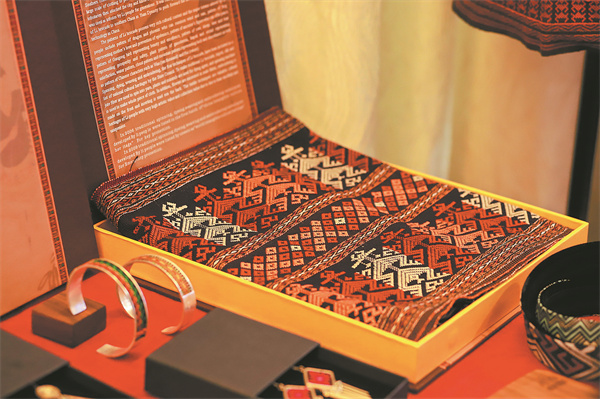
Wang's brocade products include earrings and round fans, as well as traditional cloth for dressmaking.
Influenced by his family, Wang gained a practical understanding and fundamental skills of the craft during his middle school years. His decision to fully dedicate himself to it came after witnessing Li brocade professionals conducting lessons at his college in Hainan.
"I saw the charm and significance of the art, which came naturally to me with my previous knowledge," he says.
After graduating in 2021, Wang sought an apprenticeship from a provincial inheritor in Hainan.
"My parents were supportive and believed that men could learn the craft," he says, adding that he also believes the inheritance of Li brocade shouldn't be limited by gender in the new era.
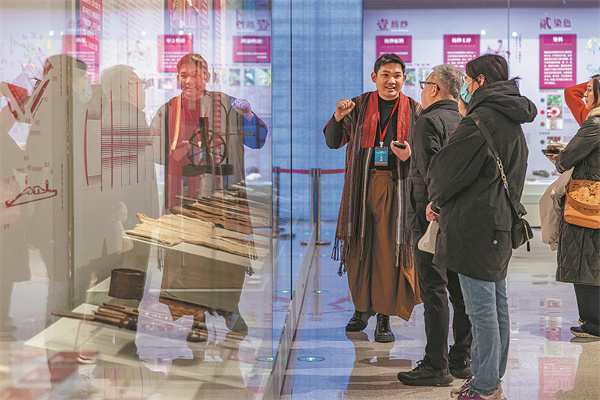
Wang Zhongwen walks visitors through the history of Li brocade at a museum in Beijing in 2024.
Wang admits that he was not as meticulous or orderly as his female counterparts, but the learning process made him more focused, improving his skills over time.
Additionally, as a male practitioner, Wang delivers a distinctive approach.
"My color choices are often bolder, with deeper, more saturated tones," he explains.
"I also focus more on simplicity in the lines and patterns, allowing the raw power and beauty of the designs to stand out."
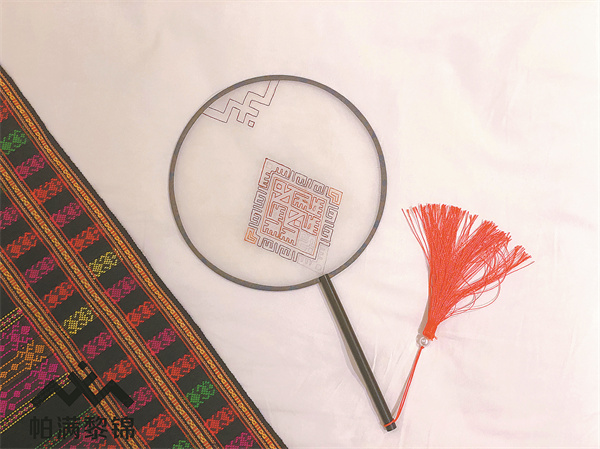
Wang's brocade products include earrings and round fans, as well as traditional cloth for dressmaking.
Yet, he insists on keeping to tradition in regard to the intricate symbols woven into the fabric that carry profound cultural significance. "I emphasize the primal strength and elegance inherent in these patterns."
Years of practice have given Wang a firm grasp of all the traditional skills, getting it down to a fine art and completing tasks independently.
"The highlights of Li brocade from our area include one-sided embroidery and pick-stitching," he says.
Wang has become something of a public figure in promoting the art at various exhibitions across the country.
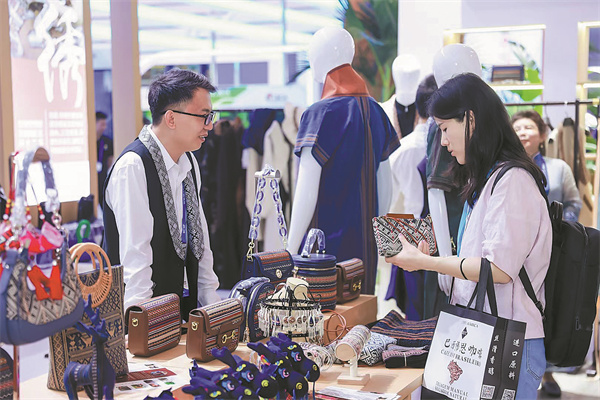
Fu Qirong displays his brocade products at a cultural expo in Shenzhen, Guangdong province.
Like Wang, Fu Qirong felt the weight of inheriting the art from his grandparents, mother and aunts since childhood.
The man, in his 30s, grew up wearing Li brocade made by his elders and saw how they imparted the skills to the family's younger generations.
The deep-rooted family tradition had Fu bring together local weavers in his hometown of Dongfang city, on the west coast of Hainan, in 2018, when he was still a junior studying at the Yangtze University's College of Arts and Sciences based in Central China's Hubei province.
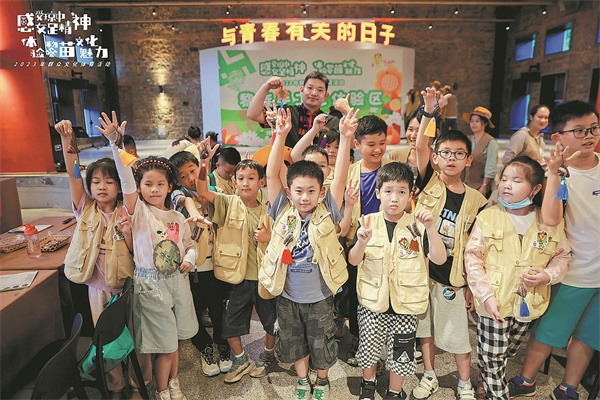
Youngsters get a close look at the craft.
"No one had a Li brocade business in the neighborhood," Fu recalls.
"Since I was very attached to the art, I decided to return to my hometown and start a business out of it."
He then went door to door, talking to local households about his business plans, and managed to get more than 70 local Li brocade practitioners on board and founded a cooperative.
After getting the ball rolling, Fu returned to Dongfang and dived headfirst into the revival of the Li brocade trade upon graduating in 2019.
In the following two years, Fu expanded the business, securing orders worth hundreds of thousands of yuan from the Hainan market. He then distributed the work back to the cooperative's weavers, establishing a reliable income stream for them and fostering the cooperative's growth.

Wang demonstrates the craft to visitors in Qiongzhong Li and Miao autonomous county, Hainan province.
The initial success encouraged Fu to attend more exhibitions and trade fairs nationwide to introduce the ancient craft to a bigger audience.
In 2022, Fu participated in the China (Shenzhen) International Cultural Industries Fair, a cultural trade event, and presented various Li brocade products covering clothing, bags and jewelry.
His display immediately caught the attention of a company from Guangdong province, which placed a bulk order for 100 handcrafted pieces.
It proved to Fu that Li brocade could be appreciated outside Hainan.
As Fu continued to make the presence of Li brocade bigger at international events, such as the China (Hainan) International Tropical Agricultural Products Winter Trade Fair and the China International Import Expo, his product sales have reached 1 million yuan annually in recent years.
Speaking about his future, Fu says he will continue to tap into the potential of integrating tradition with entrepreneurship and show the world the beauty of Li brocade.
Efforts by male artisans like Wang and Fu, along with the local government's initiative to promote the cultural heritage across local institutes of higher learning, have inspired hundreds of young men in Hainan to join in Li brocade production and trade, breaking free from the gender norms that once confined the craft and infusing the tradition with renewed vigor, according to local authorities.
Wang is preparing to demonstrate the Li brocade craft through the local government's Douyin account in March.
He says he wants to display the art's charm and share his story to inspire more young people to join the trade.
Public recognition has made him determined to transform Li brocade into a modern cultural force.
So far, he has opened his own Li brocade studio, blending the time-honored craft with contemporary designs. His creations range from traditional costumes to accessories like earrings and bracelets with Li brocade elements.
"I have about 3,000 online fans. While this may not seem like a large number, a majority of them have placed orders, resulting in a notably high conversion rate," Wang says.
"Looking back, I made the right choice in pursuing Li brocade."